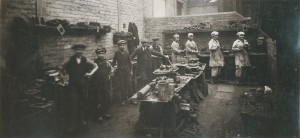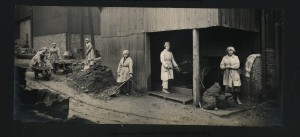Great North Greats is an exhibition exploring the history of individuals that have made the North East what it is today. One of the region’s less well known individuals was Rachel Parsons, as revealed below by David Wright from Tyne & Wear Archives & Museums.
Whenever the name Parsons is mentioned, more often than not, it is in reference to Charles Parsons and his pioneering vessel Turbinia. Much less celebrated is his daughter Rachel, a woman ahead of her time with a fascinating life story.
Born in 1885, the experiences of her youth prepared Rachel for a life away from the conventional path women were expected to follow at the time. She always had an interest in science and would often help her father with his projects, even accompanying him aboard Turbinia during its first trials at sea.
Determined to progress in the male dominated world of industry, Parsons went to study at Cambridge University. Despite being one of the first three women to study Mechanical Science there, Parsons never received her degree as women were not allowed to become full members of the University.
At the outbreak of World War I, the 29 year old Parsons took up a place on the board of directors of the Parsons’ Works in Heaton, Newcastle. Filling the role vacated by her brother, she became one of just a few women in the country to hold such a high position in industry.
Parsons’ background led to her taking up a specialist role for the training department of the Ministry of Munitions, providing guidance to thousands of new female workers taking up mechanical jobs on Tyneside.
As soldiers began to return from the war, Parsons was frustrated by government legislation that forced women out of work to make way for men, and began to actively campaign for equal employment rights for women. She clearly laid out her views in an article for the National Review:
Women must organize – this is the only royal road to victory in the industrial world. Women have won their political independence; now is the time for them to achieve their economic freedom too.
It was this manifesto that served as the rallying cry of the Women’s Engineering Society, which Parsons founded along with her mother in 1919. Serving as the society’s first president, Rachel Parsons pressed the agenda of equal employment rights for women in industry that the society continues to promote to this day.
The following year, Parsons was part of a group of young women engineers that founded Atalanta Ltd., the world’s first all-female engineering firm.
Buoyed by her success in raising the profile of women’s economic rights, Parsons decided to enter the political world and became a member of the London County Council for the Progressive Party. Parsons’ high profile brought her influential friends and she often entertained society figures and visiting dignitaries at her London home.
The death of her mother and father in the early 1930s can be seen as a turning point in the life of Rachel Parsons. The vast wealth which she inherited was widely reported and began to bring her unwanted attention.
By the time Parsons moved out of London at the outbreak of World War II, rather than devoting time to expanding her social circle, she found a new love in buying and training race horses. True to form, Parsons fell out with the Berkshire Jockey Club who opposed a woman training horses on the heath, leading her to develop her own stables on her 2,600 acre estate.
Perhaps due to a lifetime of campaigning and conflict, Parsons had become increasingly combative, not least with her stable staff who would regularly be dismissed as rats and guttersnipes, with any riposte leading to a lashing from her handbag.
Although undoubtedly fierce, Parsons was generally viewed as eccentric rather than dangerous, which made the clash which led to her death all the more surprising.
A stable boy named Dennis Pratt had been warned by police to stay away from Parsons’ estate after stealing some of her property in a dispute over withheld holiday pay. Ignoring this demand, Pratt confronted Parsons at her home and felt the wrath of her famous handbag. His response of three blows to the head with an iron pipe would leave much more lasting damage.
Arrested the next day while trying to sell some of Parsons’ property in Cambridge, he began his statement to the police with the words: “This will be a shock to you, I’ve done her in!”
Sure enough, Rachel Parsons’ body was found that day hidden in the larder of her home.
It is a sad irony that a woman who spent her life fighting for justice and successfully campaigning for ground-breaking rights for women was killed over such a small and trivial quarrel.
The combative nature of Parsons was a major part of her success, but ultimately also led to her downfall. Despite the controversial end to her life, Rachel Parsons’ work in campaigning for equal educational and employment rights for all women, regardless of their background is an achievement which should not be forgotten.
Great North Greats is a touring exhibition celebrating the millionth finish of the Bupa Great North Run and Tyneside’s incredible sporting and industrial heritage. It is on show at Cleadon Park Library in South Shields until 3 January 2015. Supported by Heritage Lottery Fund, Arts Council England and Port of Tyne.
Next year Henrietta Heald – author of William Armstrong: Magician of the North – will come to Discovery Museum to talk about Rachel Parsons and her role in training women engineers during the Great War. Rachel Parsons: Queen of the Machine will take place on 25 April 2015 as part of Wor Life 1914-1918.


2 Responses to Great North Greats – a guest post by David Wright